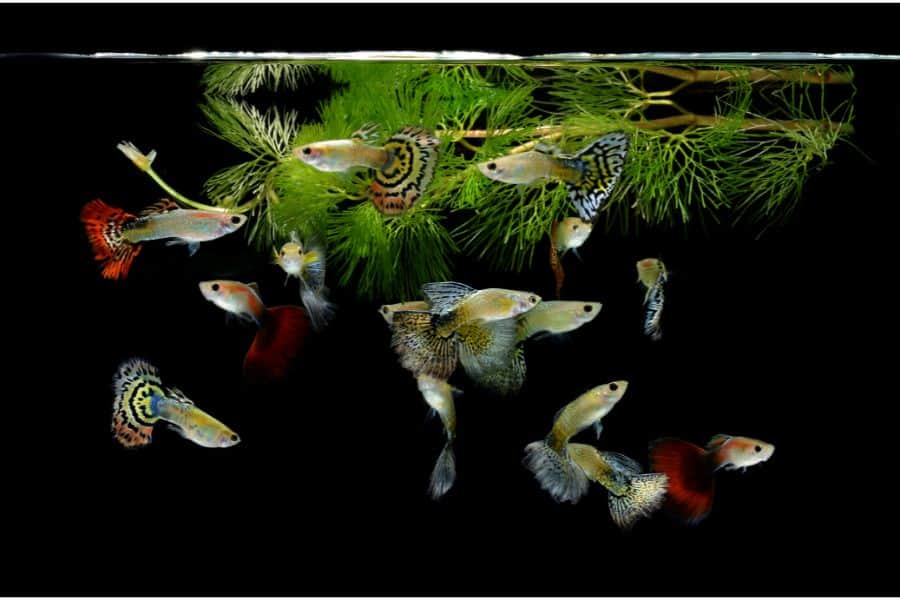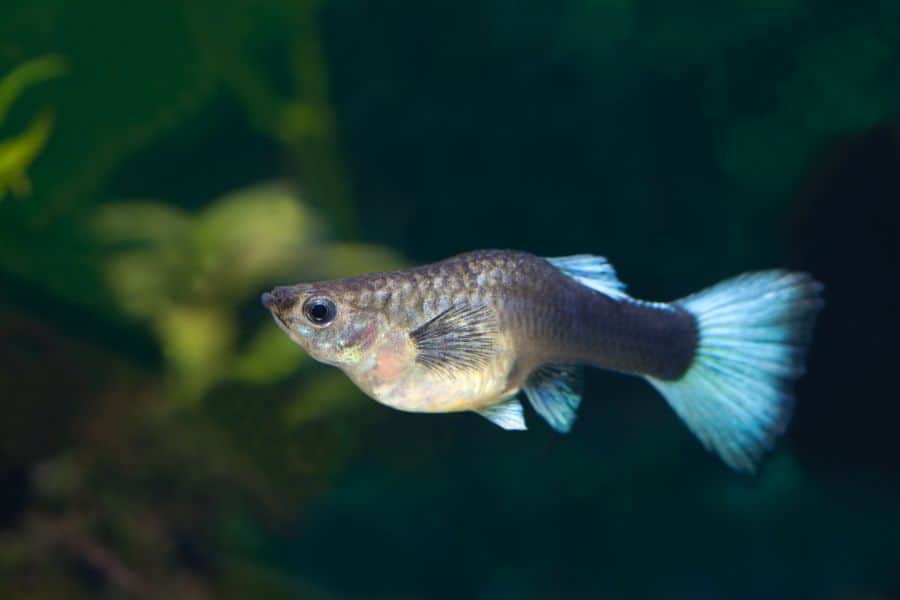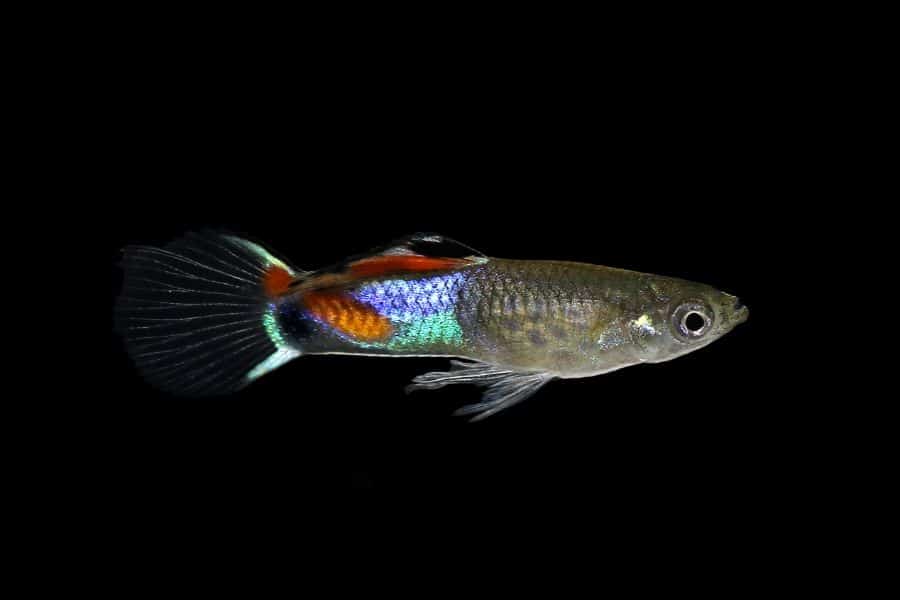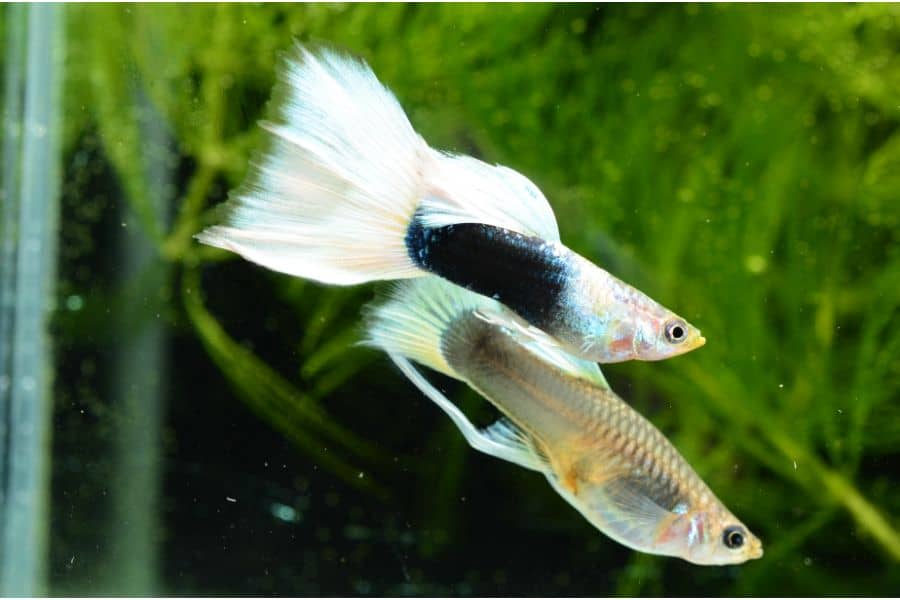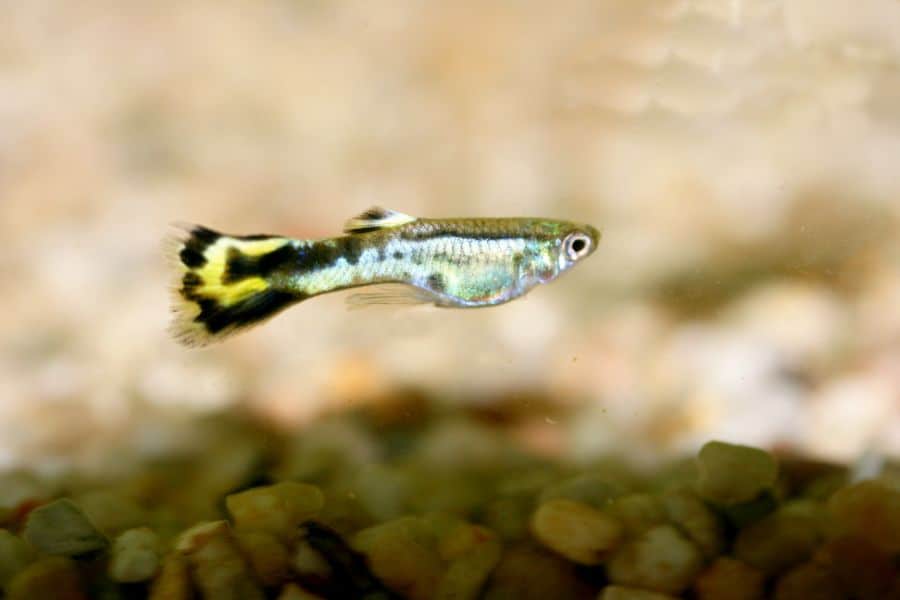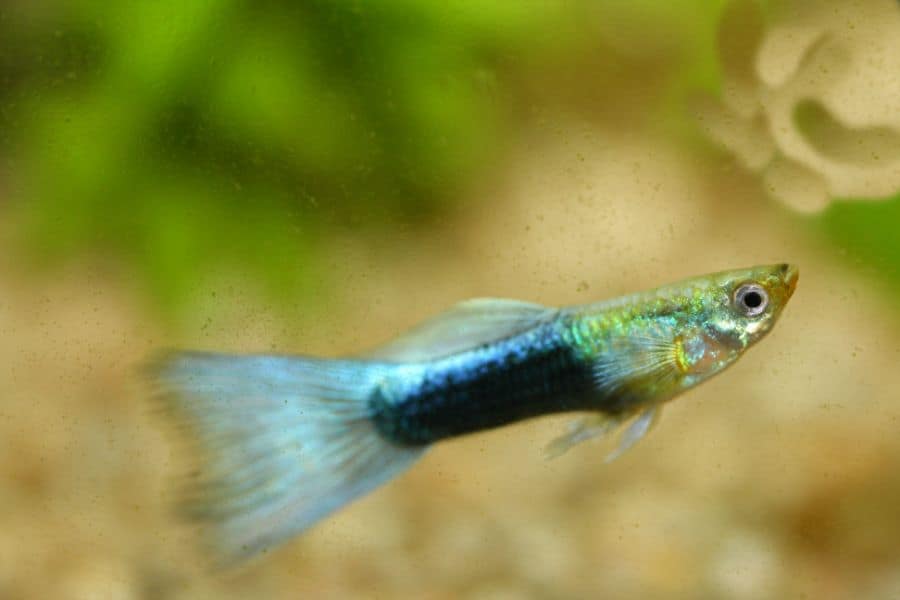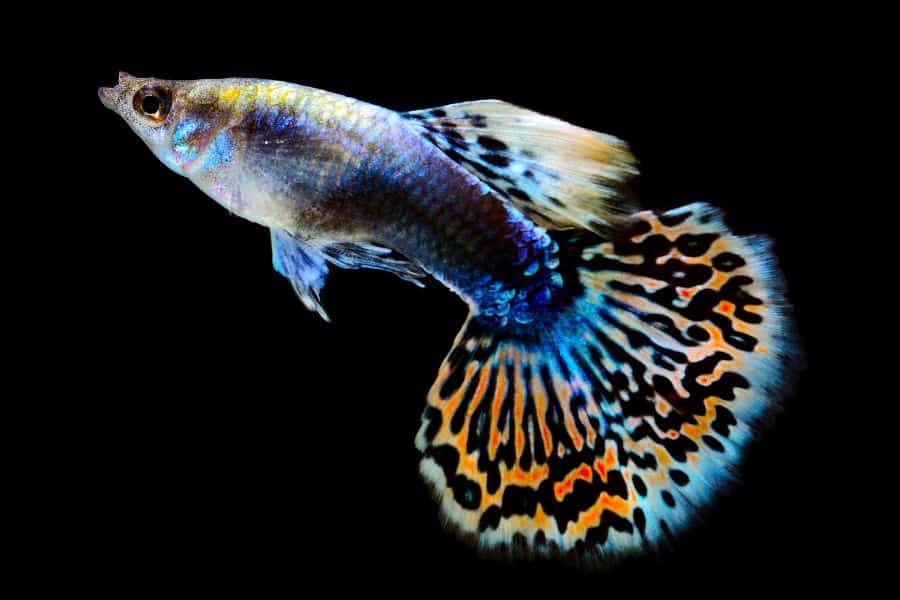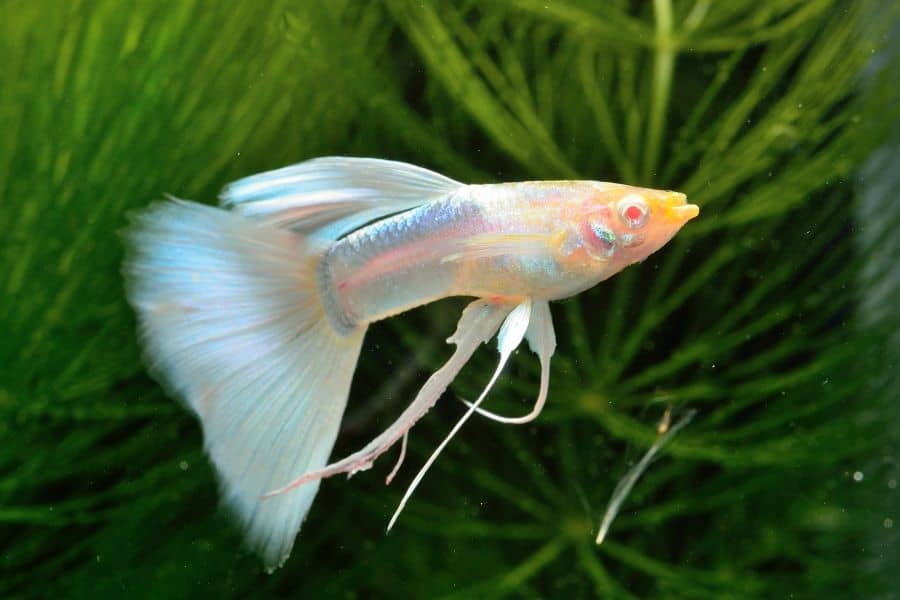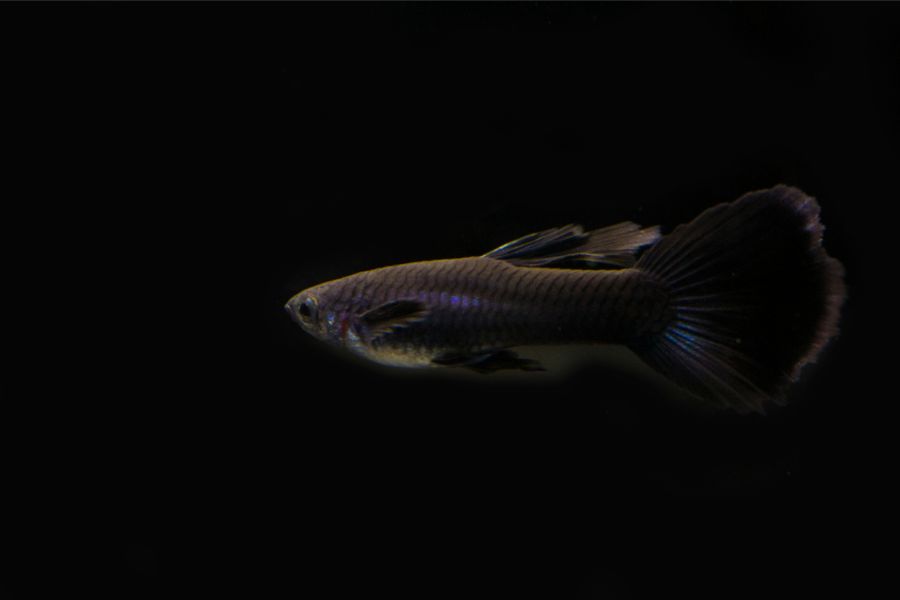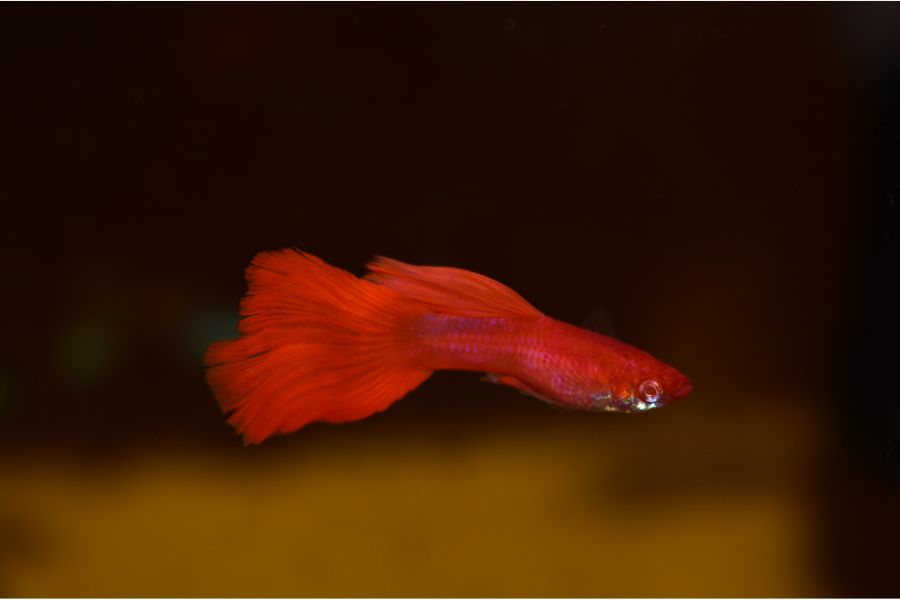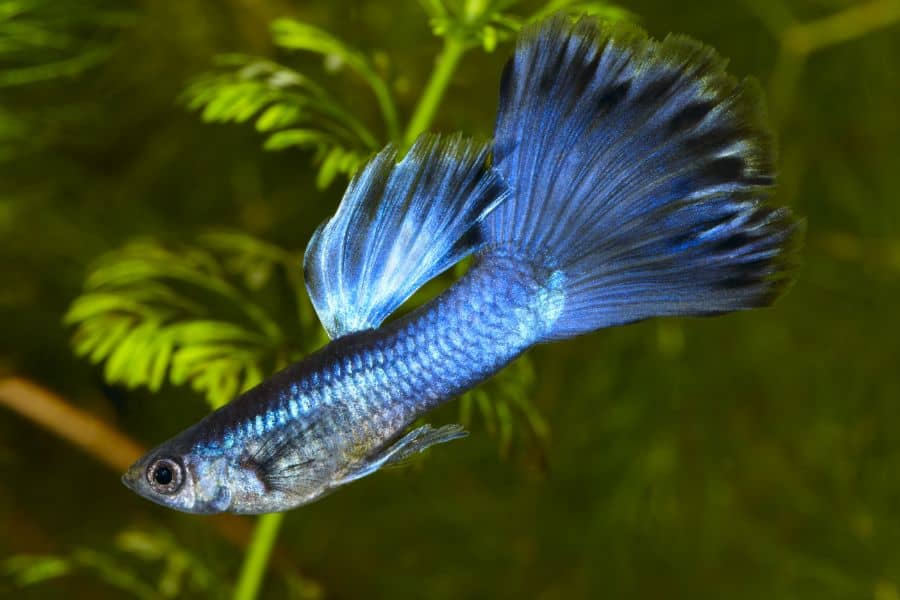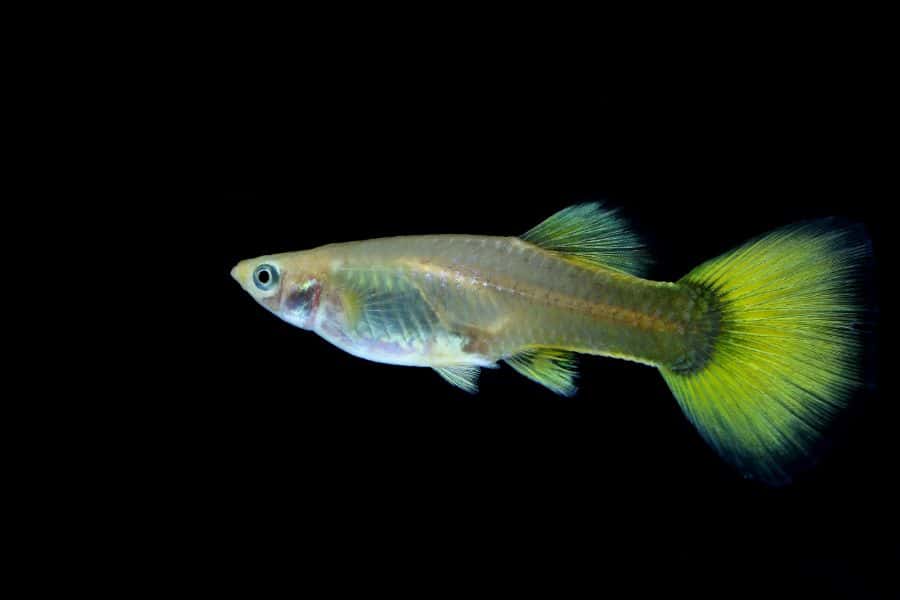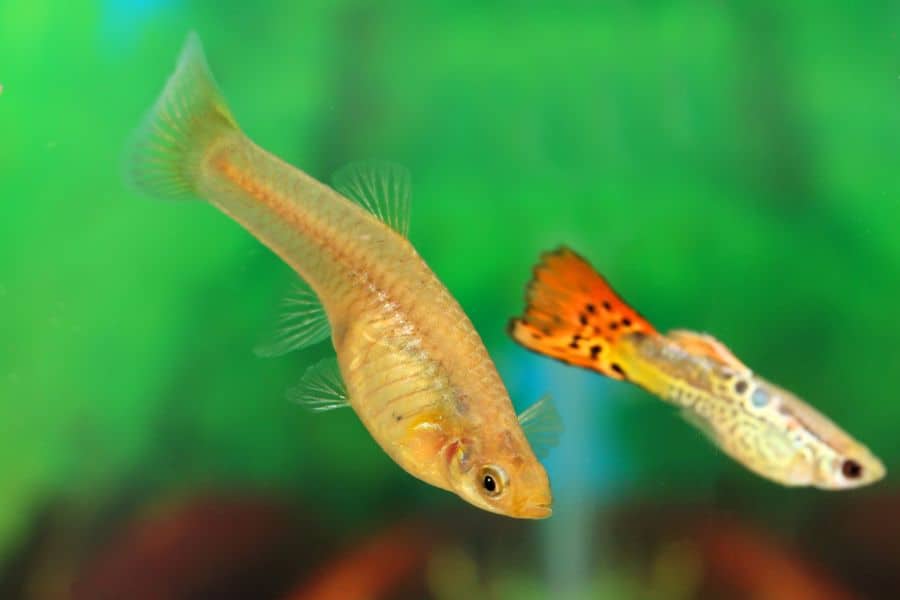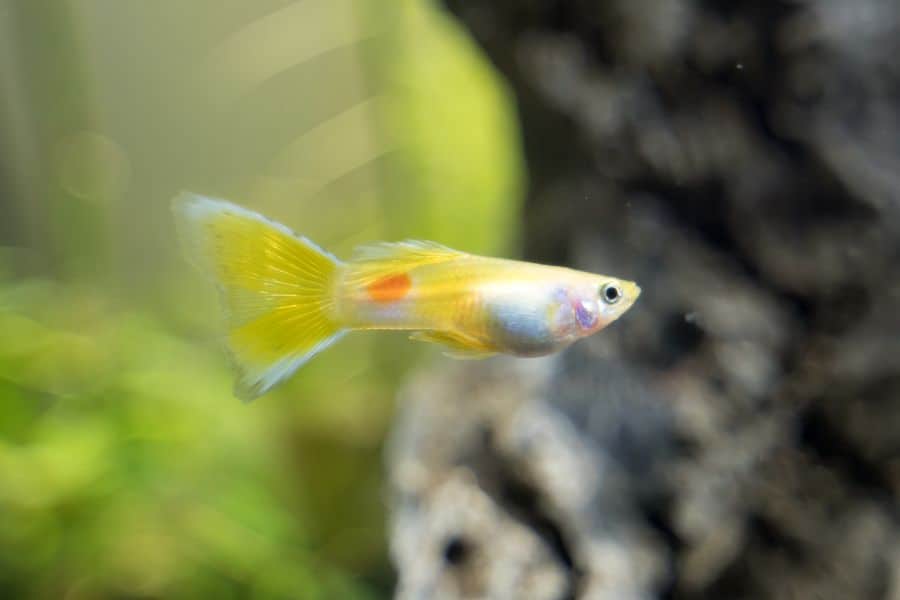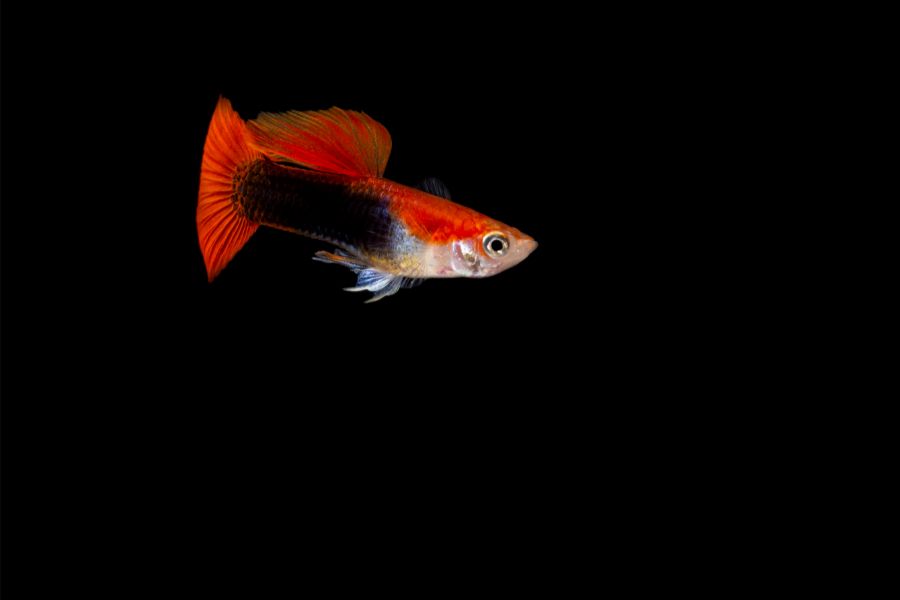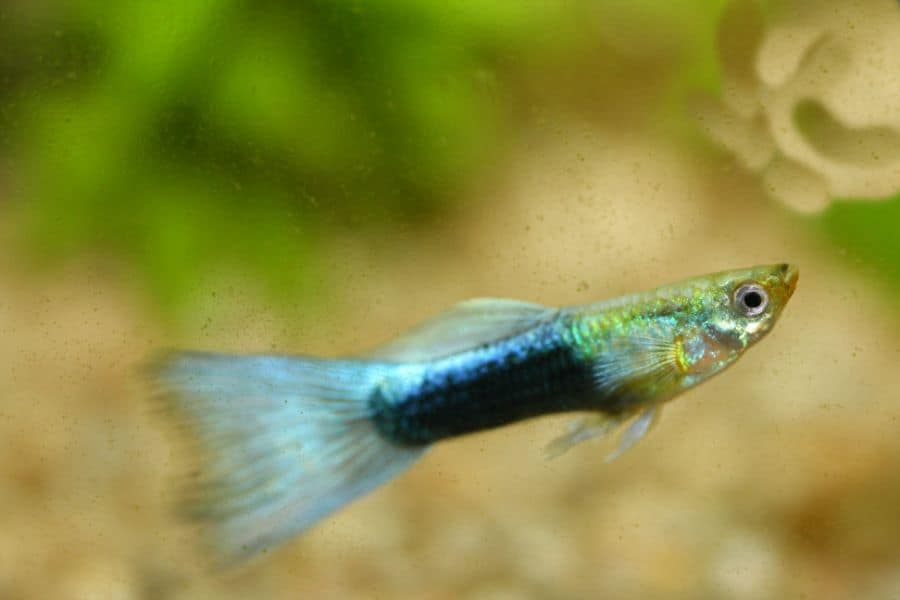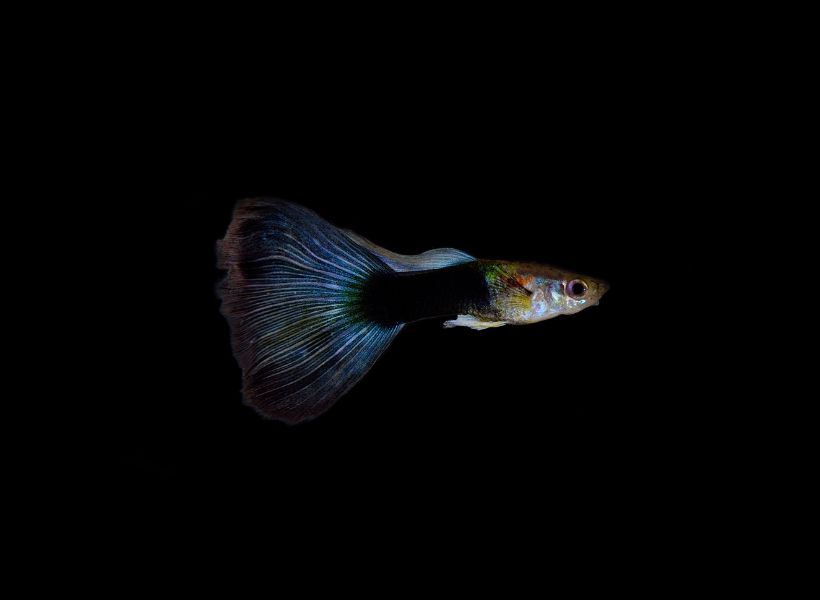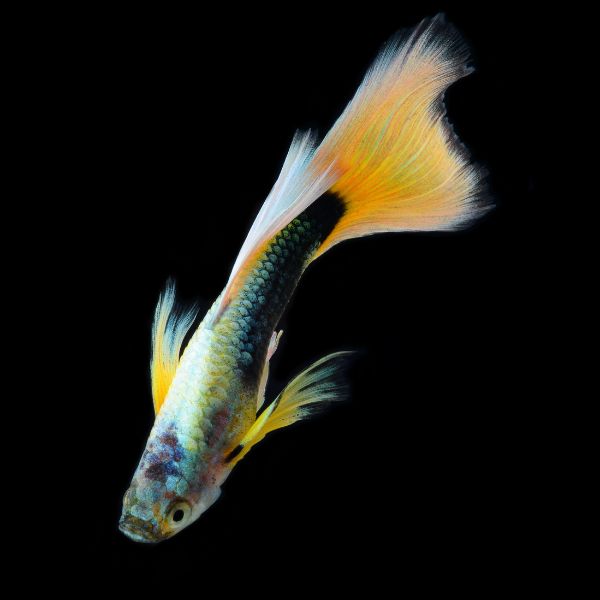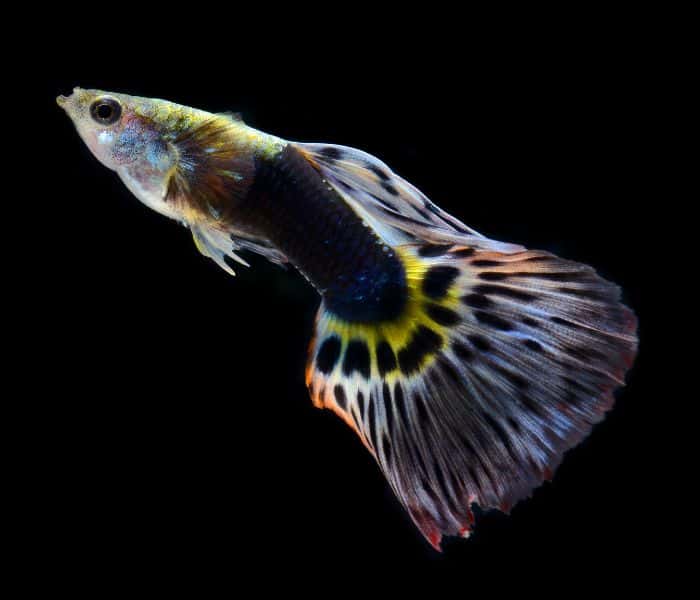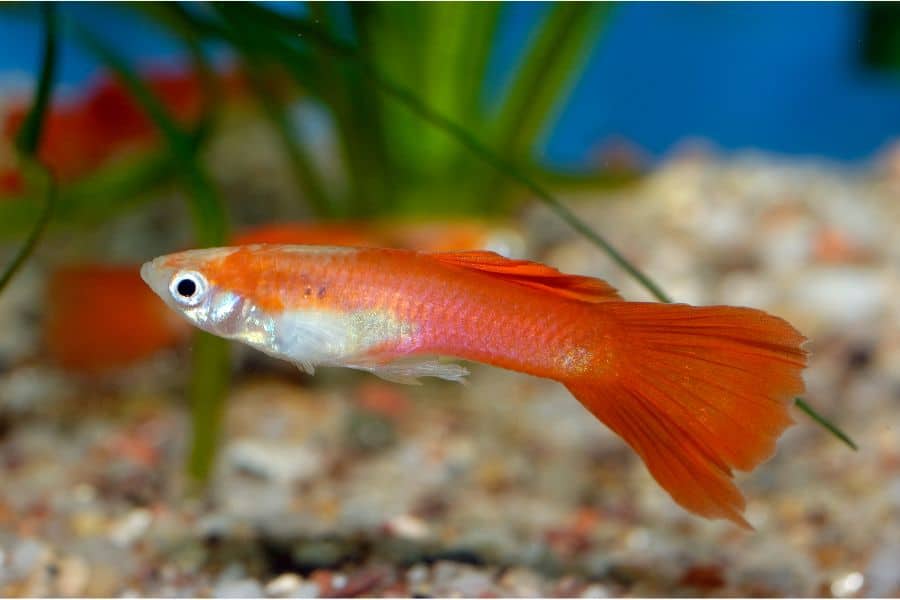Millionfish is often the alternative name given to Guppies, and they earn it due to its reputation. These small-sized fish (2.5 to 7 cm) are hardy, easy to care for, and multiply fast.
Many aquarists have experienced that even if they give little attention to their Guppies, they still reproduce, and their population can increase tenfold. Do you want evidence? Go to the nearest canal, and you will be surprised to see Guppies thriving.
Now, if Guppies can multiply and survive unattended, how much more if they are bred in captivity that is given with utmost care and provided with living conditions that are highly conducive for reproduction.
It is why Guppies have evolved from a few original species in the wild to nearly 300 varieties through crossbreeding.
In this article, we will feature the types of Guppies commonly bred and group them according to their body feature that will become your basis in identification.
Male-based Identification
Guppies are sexually dimorphic. It means that the males are physically different from the females, even if they belong to the same species.
Although not always, the physical characteristics of male Guppies are often the basis of their name. Sexually wired to attract females during courtship, males exhibit distinct and striking qualities (such as color variation and fin shapes), making them easier to identify and differentiate them from other species of Guppies.
On the other hand, female Guppies don’t have unique and flashy traits. Well, to some extent, they do, but not as extravagant as those of male Guppies.
Instead, the evolutionary development of female Guppies is focused on reproduction and producing healthy offspring. It is why they are larger, particularly their tummies.
Types of Wild Guppies
Guppies belong to the Family Poeciliidae, and the distinct feature of this group of fish is their different color varieties.
Worldwide, there are over 300 species of wild Guppy, and some of them are traded in the aquarium industry as pure breeds.
Fancy Guppy (Poecilia reticulata)
From their origins in South America to their vast introduction across many countries as an agent for mosquito control, the Fancy Guppy has a wide global distribution, thus they are tagged as the Common Guppy.
While they are considered the largest type of Guppy where the females can grow up to 7 cm long, the males are only half the size. Aside from their size difference, you can distinguish the gender by the color pattern. Females are generally plain gray while the males have colorful spots and stripes.
Endler Guppy (Poecilia wingei)
The Endler Guppy is closely related to the Fancy Guppy, except they are smaller. The fact is that they are the smallest of all Guppies, where the males only grow up to 2.5 cm and 4 cm for the females.
While the females have a monotone gray color, the males have colorful patterns and stripes mainly composed of red, orange, blue, green, yellow, and black.
Further, you can identify a male Endler Guppy by looking at its caudal fin since it has a distinct color pattern where the upper and lower tips of its tail are colored, while the middle is transparent.
Naming the Endler Guppy can be attributed to two persons. Although its species name was in honor of Danish biologist Ojvind Winge, its common name was attributed to evolutionary biologist John Endler when he rediscovered this fish during a Venezuelan scientific expedition back in the 70s.
Swamp Guppy (Micropoecilia picta)
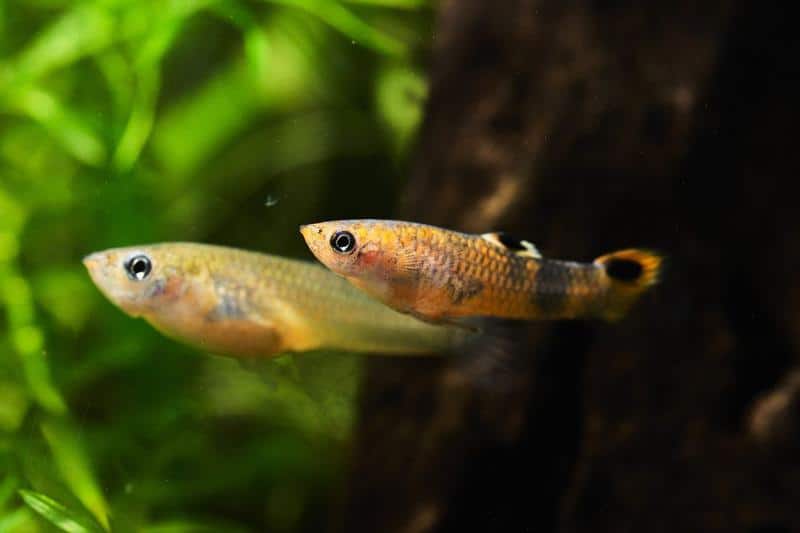
Not all Guppies are freshwater. Some can thrive in brackishwater, like the Swamp Guppy. In their wild habitat in South America, they prefer to live in coastal swamps and seldom go far inland.
Also called Painted Guppy, the males of this species are multi-colored and look similar to those of an Endler Guppy. However, you can still differentiate them as male Swamp Guppies have no colored tips in their caudal fin.
Types of Guppies According to Caudal Fin Shape
Crossbreeding in Guppies is common. From pairing popular purebreds we mentioned above, as well as other less-known wild species, aquarists have come up with numerous hybrid Guppies.
In most cases, these hybrids have highly desired traits that add more beauty to this group of fish, like the development of various caudal fin shapes.
Fantail Guppy
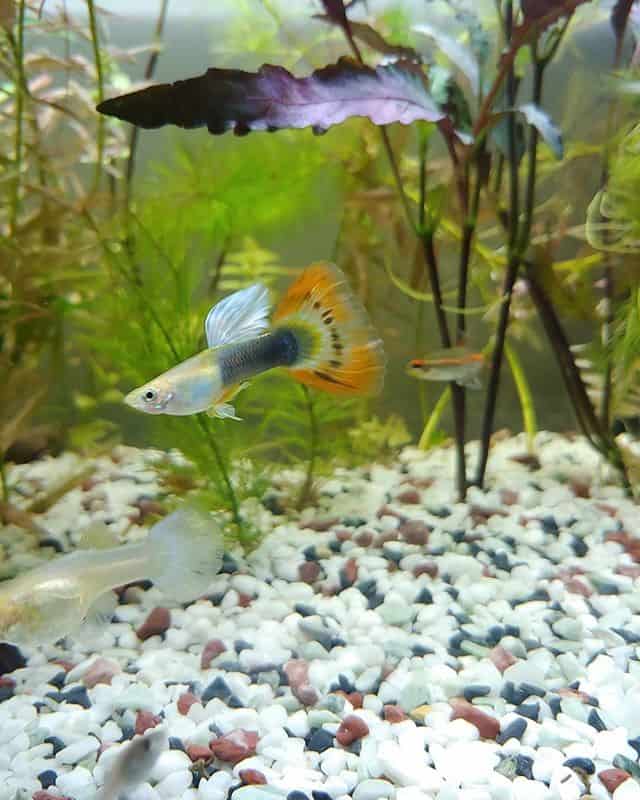
All the fins of a Fantail Guppy are elongated and highly developed, except for their regular-sized pectoral, pelvic, and anal fin.
Although their dorsal fins are relatively long and erect, their caudal fin is more pronounced and has been the basis of their name. As the fish swim, you can see how their caudal fin sways and resembles an open fan.
While the caudal fin of a Fantail Guppy may come in a variety of colors, what is common is their symmetrical pattern.
Veiltail Guppy
When it comes to similarities in their caudal fin, the Fantail Guppy and the Veiltail Guppy have a lot in common. Both types of Guppies have a triangle-shaped caudal fin with color patterns that are symmetrical in design.
The only distinguishing factor is that the caudal fin in Veiltail Guppies is more elongated, flowing and wavy. The fact is that Guppies that have some of the longest caudal fins are veiltail varieties.
Delta-tail Guppy
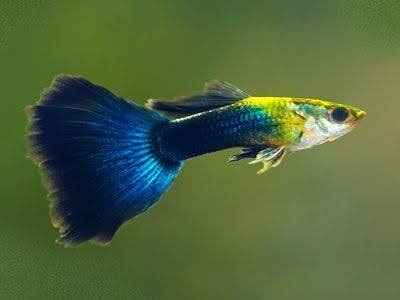
For a newbie aquarist, the caudal fin of a Fantail, Veiltail and Delta-tail Guppy may look the same. But for the experienced, they are different.
For the Delta-tail Guppy, you can identify them using these methods.
First, this fish has a perfect triangle shaped tail, thus its alternate name – the Triangle-tail Guppy.
Second is you can ask why they bear the name delta.
Just imagine you are in an airplane and you see a river delta flowing into the ocean. Or if that’s too complicated for you, just focus on the Greek letter delta which has a symbol “Δ”.
Flagtail Guppy
The caudal fin of a Flagtail Guppy is short, narrow, and not as elongated as those of Fantails and Veiltails, but wavier.
When a Flagtail Guppy swims, you can see how its caudal fin waves, sways, and flows behind its body, giving you the impression of a flag or a scarf being blown by the wind, thus its alternate name – the Scarftail Guppy.
Double Swordtail Guppy
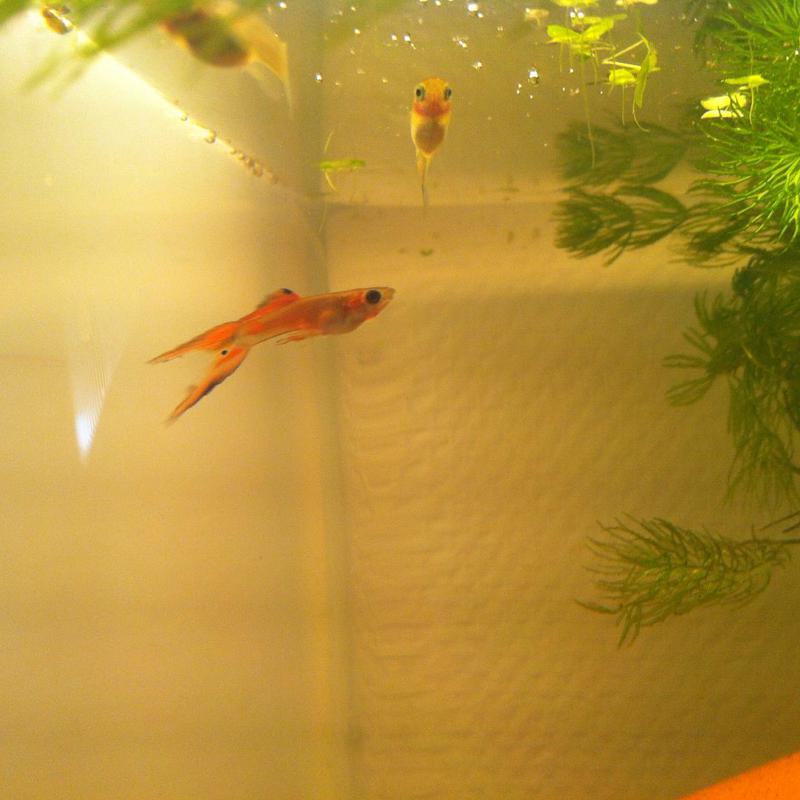
We admit that recognizing the Fantail, Veiltail, Delta-tail and Flagtail Guppy can sometimes be confusing since their caudal fins look similar. However, with the swordtail varieties of Guppy, identifying them is easy as counting 123.
In guppies, sword is a term used to describe the elongation of their caudal fin on one side that sharpens and tapers to an end. For the Double Swordtail Guppy, the upper and lower edges of their caudal fin are elongated and tapered.
In most cases, the swords of this fish are straight and symmetrical. However, with continuous crossbreeding, some aquarists have produced Double Swordtail Guppy with caudal fins that are curved and asymmetrical.
Lyretail Guppy
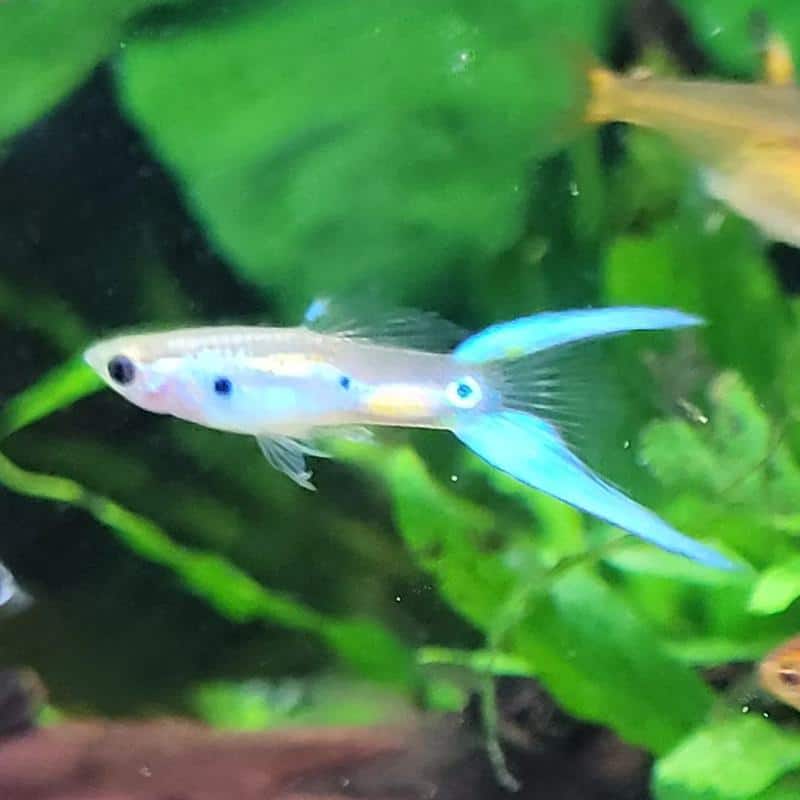
Looking at this fish initially gives you an idea that they are a crossbreed variety of the Double Swordtail Guppy. Well, yes, they are.
The striking colors at their lower and upper caudal fin look like they are swords. Well again, yes, but in a unique way. Instead of highly elongated, they are only partly protruding but with a distinct color at both ends that looks like a double sword.
Another thing that differentiates them from the Double Swordtail Guppy is that their fins are connected via a transparent membrane that looks like strings from a musical instrument, thus its name.
Top Swordtail Guppy
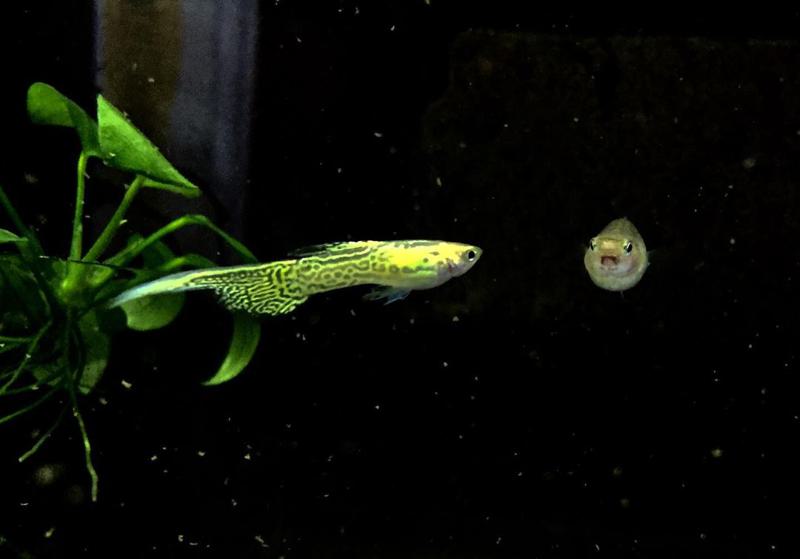
As the name of this fish suggests, their caudal fins are asymmetrical. Only their upper caudal fin is elongated, while the lower caudal fin takes a regular shape.
With continued crossbreeding, the sword of this fish is not always elongated and black since some aquarists were able to produce mid-sized and colorful fin varieties.
Bottom Swordtail Guppy
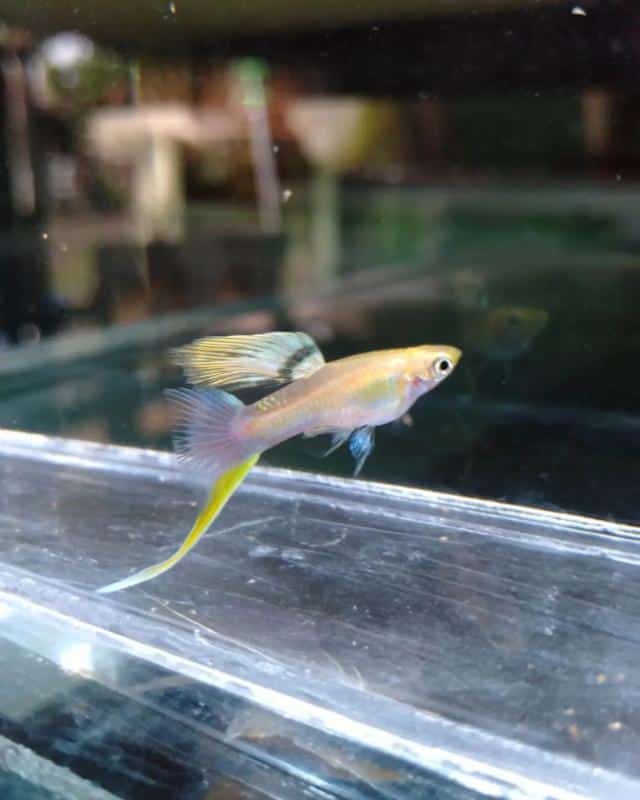
Another example of Guppies with asymmetrical caudal fins is the Bottom Swordtail Guppy. Opposite to those of the Top Swordtail Guppy, this fish has an elongated lower caudal fin, while the upper fin takes a regular fin shape.
Spear Tail Guppy
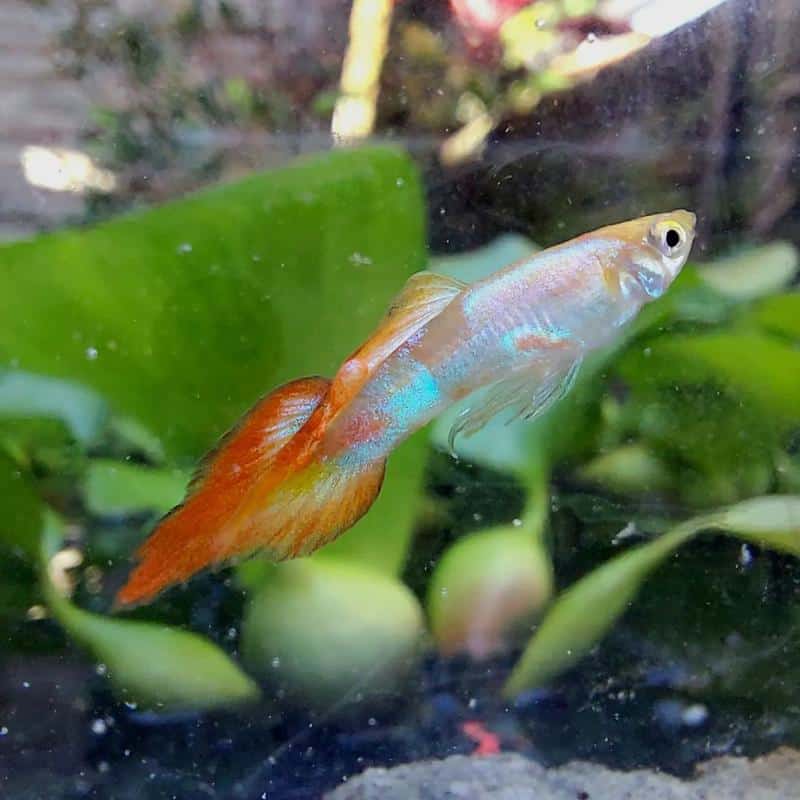
If you can imagine a sword protruding at the central portion of a caudal fin, then you have just imagined a Spear Tail Guppy.
Taking a closer look, you will see that the central protrusion in their caudal fin looks similar to the pointed tip of a spear, thus its name.
Spade Tail Guppy
If you play cards, then you have no problem identifying this fish as their caudal fin is spade-shape. It bulges on both ends and tapers at the center.
Pin Tail Guppy
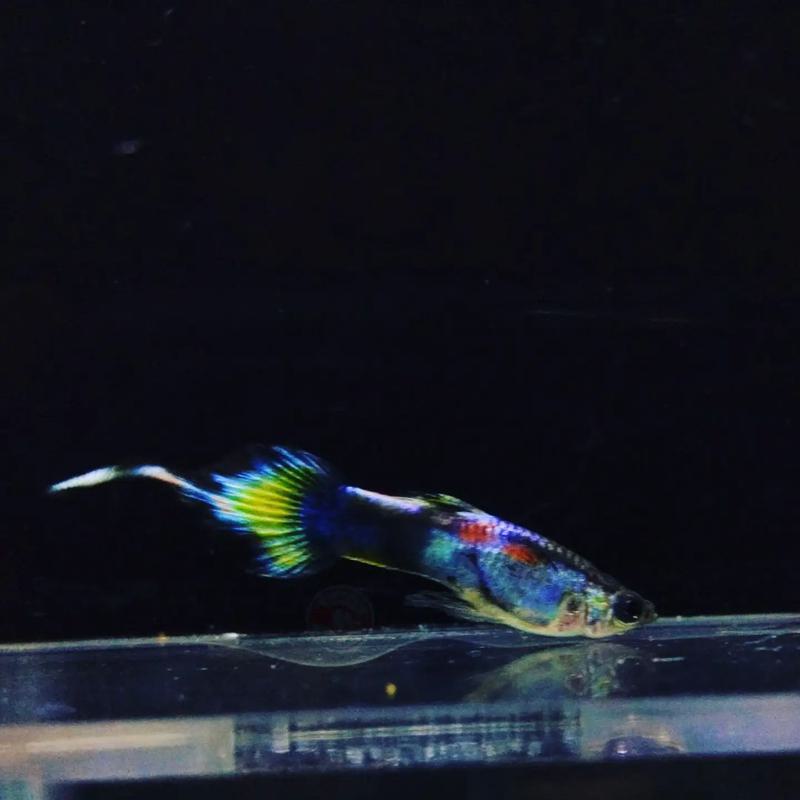
There are only three types of Guppies that have a central protrusion in their caudal fin, namely: the Spear Tail, the Spade Tail and the Pin Tail Guppy.
The only difference between the three is that the protrusion in the Pin Tail Guppy is more pointed like a needle, thus its alternate name – the Needle Tail Guppy.
Roundtail Guppy
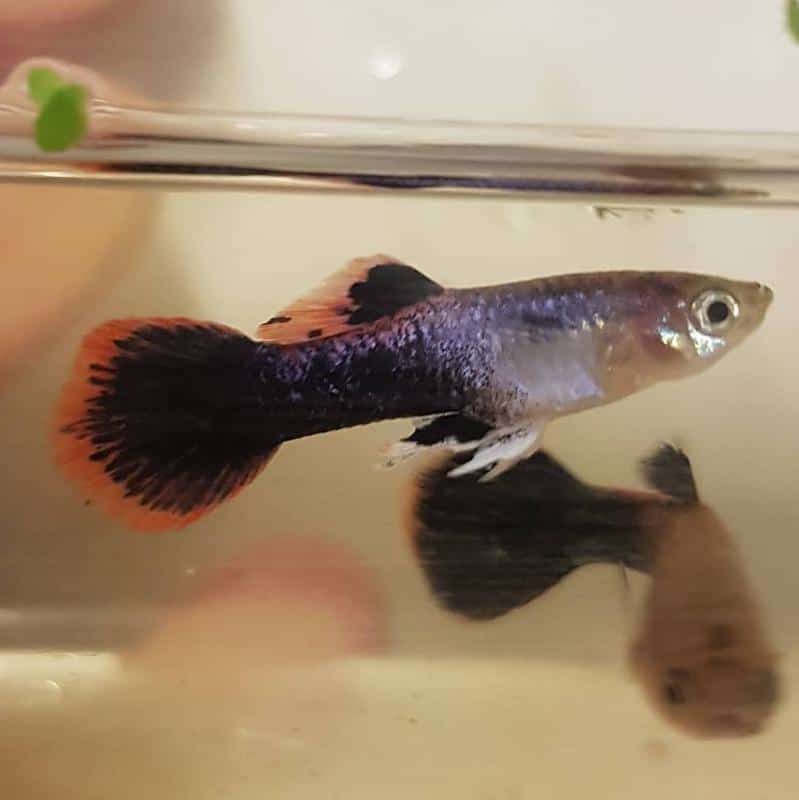
As their name suggests, this fish has a distinct circular or round-shaped caudal fin. While the round tail of this fish is pretty obvious, what is surprising is their close relation to the Spear Tail, Spade Tail, and Pin Tail Guppy.
Instead of protruding out, their caudal fin grows outward, forming a circle instead of ending at a point.
Halfmoon Tail Guppy
Although they may not be the longest, this fish has the widest caudal fin in the entire Guppy family. Their caudal fin starts out wide from the body, then pitches 90 degrees away before it forms an arch like those of a lunar half moon.
But unlike the monotonous lunar color, the tail of this fish comes in a variety of colors and patterns, making them one of the sought after types of Guppies.
Types of Guppies According to Caudal Fin Pattern
Crossbreeding in Guppies will not just yield a variety of caudal fin shapes but, with their genetic diversity, will also create colorful patterns, making them more beautiful as they swim and making their identification easier.
Mosaic Guppy
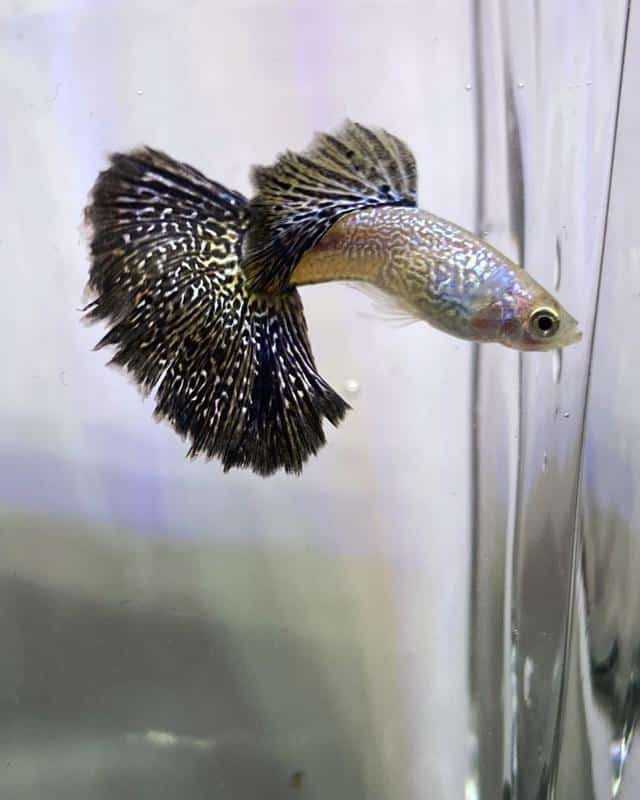
Composed of multi-colors (combination of red, violet, orange, blue, and yellow), the caudal fin of a Mosaic Guppy has colorful patterns that are not just aesthetically beautiful but also artistically stunning.
When you look at the caudal fin of Mosaic Guppy, the patterns may seem irregular. But with a closer look, you will realize that it is symmetrically arranged that it creates a hypnotizing effect.
In some varieties, the mosaic pattern is not just evident in their caudal fin, but may also be seen in their body.
Leopard Guppy
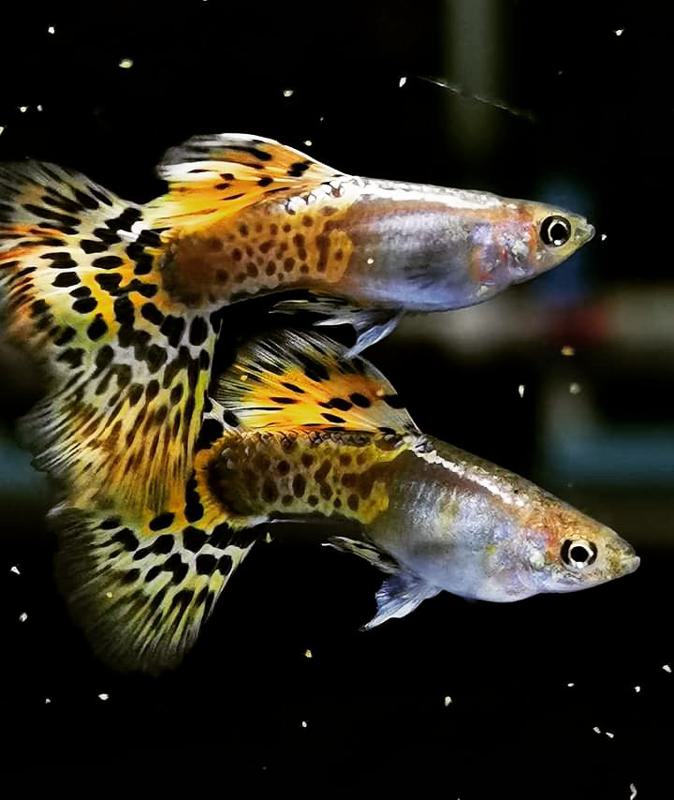
The Leopard Guppy is not the fastest swimming Guppy in the world, and speed has nothing to do with its name. Instead, the yellow and black markings in its caudal fin resemble those of the fastest land animal. And what makes these fish stunningly beautiful is that the leopard markings are present in all their fins.
Glass Guppy
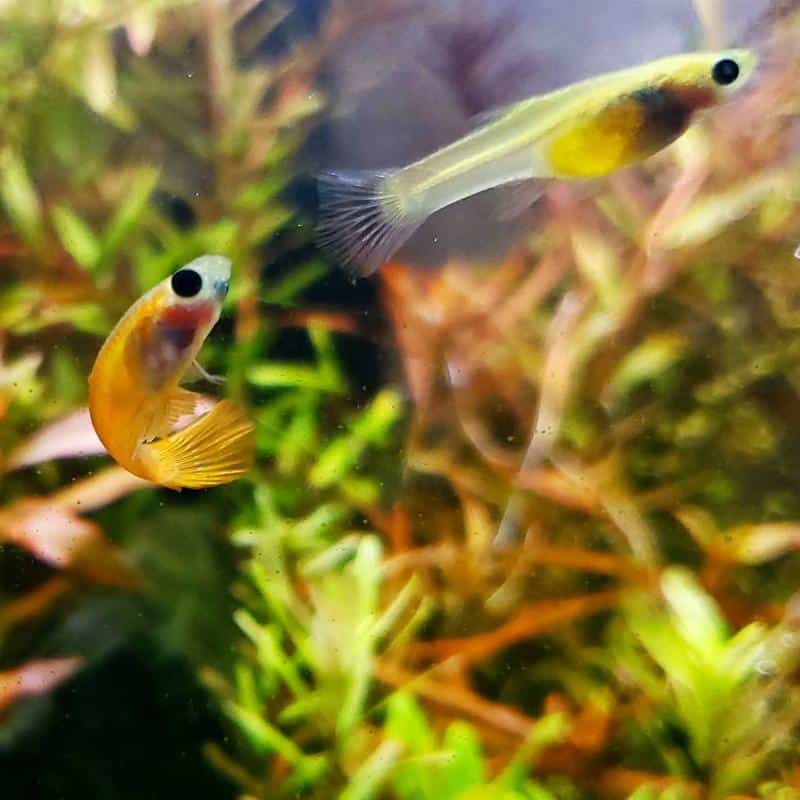
We have mentioned earlier that males are usually the basis for naming a type of Guppy. In the case of Glass Guppy, their features are more pronounced in females.
Males are partially transparent, while females are transparent starting from half of their body down to their caudal fin. They are so translucent that you can see their eggs when they get pregnant.
While Glass Guppy are sought after and considered rare, you should take note their glassy skin is a genetic mutation from crossbreeding. Their genetic makeup prevents them from producing guanine which is the pigment responsible for creating a silver coloration in fish scales.
Types of Guppies according to Solid Body Colors
Guppies are naturally multicolored. However, with crossbreeding, aquarists were able to come up and produce hybrids that have solid body colors.
White Guppy
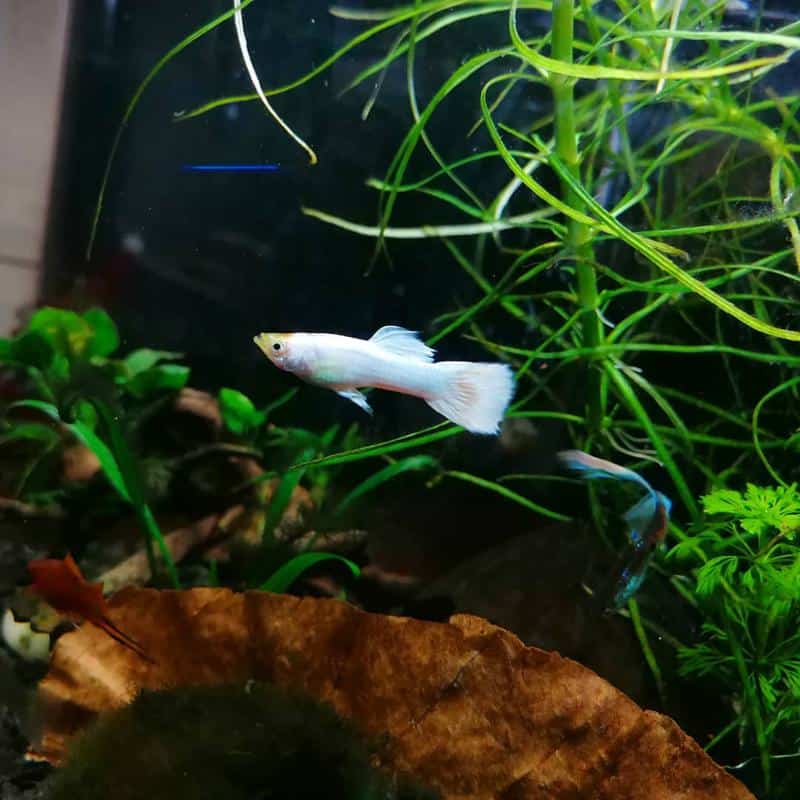
Also known as the Platinum Guppy, this fish has no pigmentation or color pattern. Instead, it is snow-colored from head to tail.
For a newbie, the White Guppy may be a monochromatic fish and just being colored white. However, wait until this fish is exposed to bright light, where its scale will shine and reflect light like those of South Sea Pearls.
Albino Guppy
Considered one of the rare breeds, the Albino Guppy is sought after by many aquarists and hobbyists. But before you buy one, be aware that its physical feature is a product of genetic mutation.
Albino Guppies have genes that hinder melanin production – a pigment responsible for body coloration. In other words, this fish has no color, and its appearance resembles those of White Guppies with a pinkish undertone that is more pronounced in their eyes.
Since they have no skin pigmentation, be aware that Albino Guppies are susceptible to skin damage from prolonged and excessive light exposure.
Black Guppy
Opposite to the absence of melanin in Albino Guppies, Black Guppies have increased levels of pigment production, causing this fish to be uniformly black throughout their bodies, fins, and eyes.
Red Guppy
Being entirely cherry-colored, the Red Guppy adds elegance to your tank and is one of the reasons why they are highly sought after.
Also known as Scarlet Guppies, these fish are widely bred in captivity and have resulted in many varieties like the Albino Full Red, Flamingo Red, Full Red Gold, and Moscow Red Guppy.
Now, if you’re wondering why they are colored red, it is because of the combination of color pigments dominated by carotenoids which is the same stain responsible for the red coloration in tomatoes.
Blue Guppy
Also known as Cobalt Guppies, this type of Guppy is entirely blue in color caused by the melatonin pigment and their unique scale structure that reflects and refracts light.
If you are keeping Blue Guppies, do not be surprised if their blue coloration fades over time. It is their natural response as they get older, and the fading of their color does not necessarily mean your fish is sick.
Since Blue Guppies are popularly bred in captivity, one of their popular varieties is the Neon Blue Guppy, where you can clearly see the striking neon coloration in their predominantly blue-colored body.
Green Guppy
As their name suggests, this type of Guppy is green in color, thus its alternate name – the Grass Guppies.
However, with selective breeding, hybridization in Green Guppies has resulted in many color varieties where some are colored olive or avocado green. Some varieties of Green Guppy also have unique caudal fin patterns like the black lines of a peacock.
Yellow Guppy
Aside from their amber-based color caused by the xanthophore pigment, the color intensity in Yellow Guppies may range from pale (like a lemon) to intense (almost golden).
In some cases, breeding Yellow Guppies may develop horizontal red streaks along their upper body, which is a clear sign of genetic variation.
Golden Guppy
While they are similar to intensely colored Yellow Guppies, Golden Guppies can easily be distinguished since their fins are paler, and to some extent, colored white.
One of the hybrids of a Golden Guppy is the Bronze Guppy which is considered genetically blonde since it has 75% less color intensity.
Purple Guppy
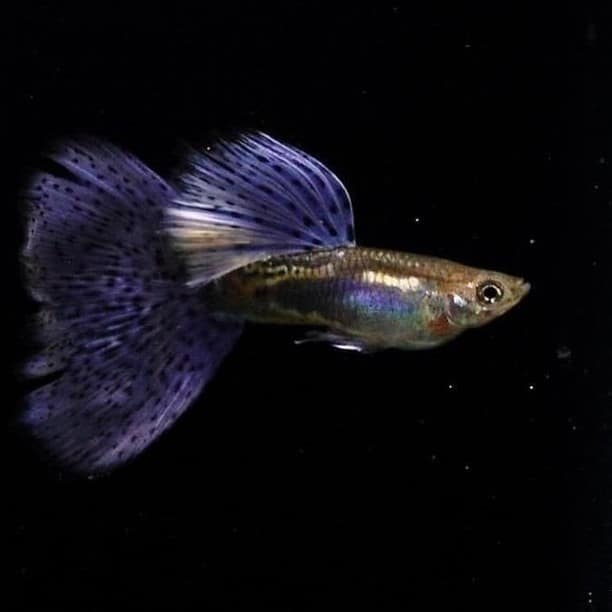
While it is a given fact that Purple Guppies are colored violet, their color intensities vary from bright purple (which is the pale variety) to intense midnight purple.
Aside from varying color intensities, the hybridization of Purple Guppies has resulted in different caudal fin shapes and patterns, like the rare Big Ear Purple Mosaic Guppy.
Moscow Guppy
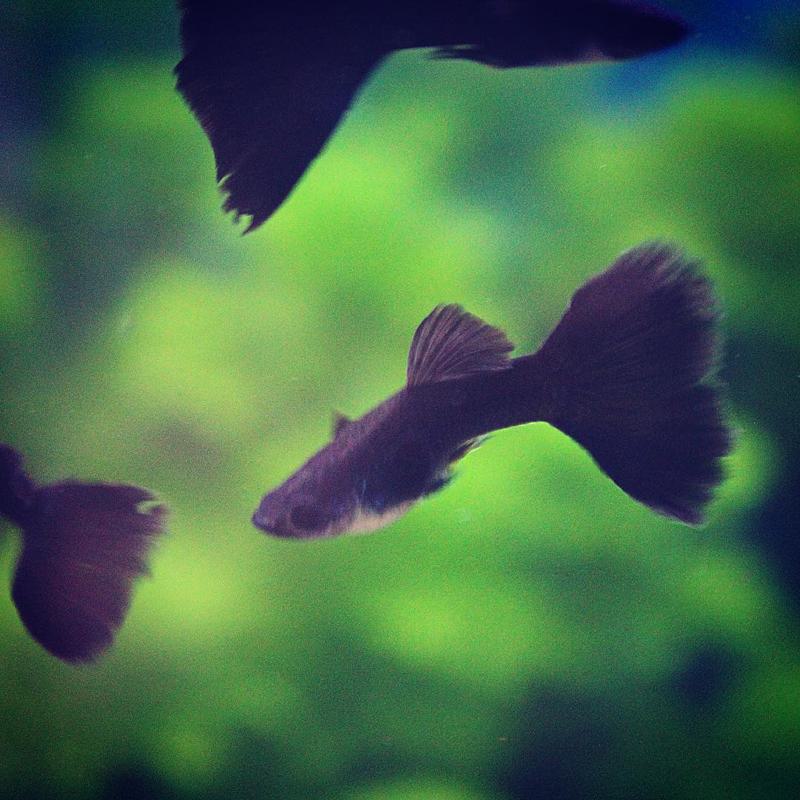
If not for their highly developed fan-shaped caudal fin, then identifying this fish is difficult since it comes in different solid colors (like purple, green, and blue).
Thanks to their original Russian breeders who cultivated them in Moscow for the sole purpose of producing highly elongated and flowing caudal fin.
Although they were not popular at the start, their popularity grew when they were smuggled to the US and American aquarists accepted them as a great piece of hybrid.
Type of Half-colored Guppies
Also known as Split-colored Guppies, Half-colored Guppies feature two distinct colors on their body. This is due to their genetic inheritance from crossbreeding that allows them to possess the “half-black” gene.
This chromosome controls the distribution of pigments in such a way that black and another opposing color are distinctly separated.
Black-Red Guppy
Although the black and red color combination of this fish is very distinct, they are not the only color present since white is also distinguishable.
While cross breeding of Black-Red Guppies continues to produce new varieties, the common pattern is that their dorsal and caudal fins are red, half of its body towards the tail is black, and their head, stomach (including the pectoral and pelvic fins) has a white undertone.
Black-Blue Guppy
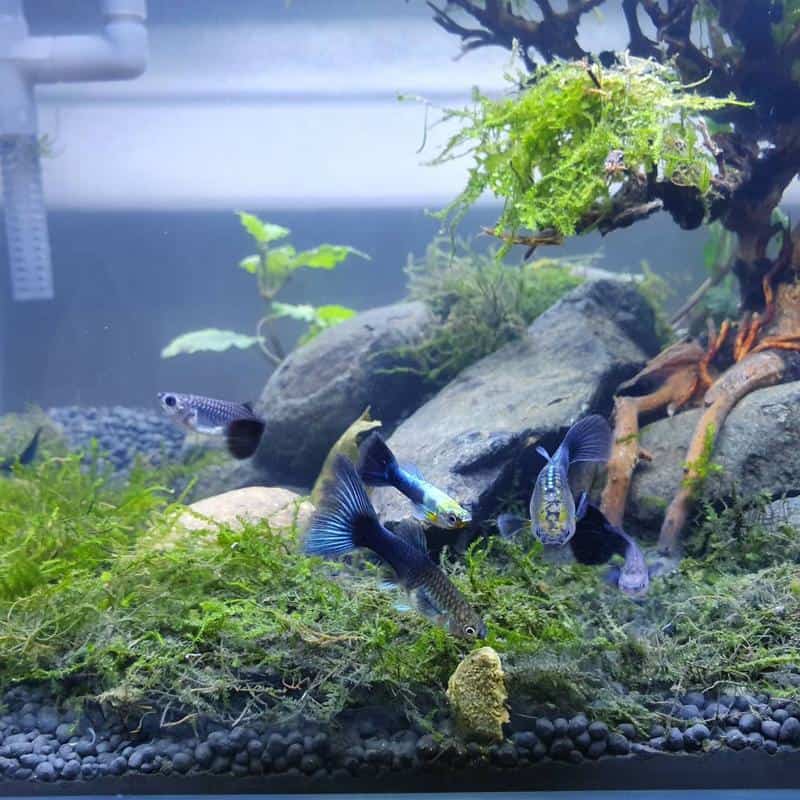
Although the name of this fish was derived from their blue-colored caudal fin and half of their body is black, white and grayish coloration is persistent in this variety, particularly at their head.
While their colors suggest a dull combination, it changes as they swim since light is reflected at different angles creating an iridescent effect.
The Black-Blue Guppy is one of the well-studied hybrids. Scientists discovered that their blue coloration is due to a pigment cell called iridophores.
Black-Green Guppy
Do not expect to see bright green colors in this fish. Instead, the Black-Green Guppy is colored grayish-white on the head, silvery black on half of their body, and their caudal fin is olive with some dashes of yellow at its base.
Black-Purple Guppy
You might be expecting that the Black-Purple Guppy is colored white on their, black on their body, and purple on their caudal fin.
Yes, you are partly correct. You just need to add some dash of green in their body and a black margination at their caudal fin, and your identification for this fish will be perfect.
Black-Yellow Guppy
Combining black and yellow creates the perfect contrast and this is what makes this fish stunningly simple yet beautiful.
Aside from their white-colored head, black body, and yellow caudal fin, what makes this fish aesthetically pleasing is their highly developed dorsal fin that also has a yellow coloration.
In some rare varieties, the Black-Yellow Guppy may also have a fantail or veiltail caudal fin with leopard-like markings.
Black-Pastel Guppy
Soft shades of black on the body and white on their head and caudal fin are the base colors of the Black-Pastel Guppies.
In some varieties, this fish may have some red undertone on their head, while a dash of yellow and green may be seen at the base of their tail.
Types of Guppies According to Body Color Pattern
Crossbreeding Guppies will not exclusively result in solid body colors. Hybrid Guppies have also developed color patterns in their body that are very easy to distinguish and identify.
Panda Guppy
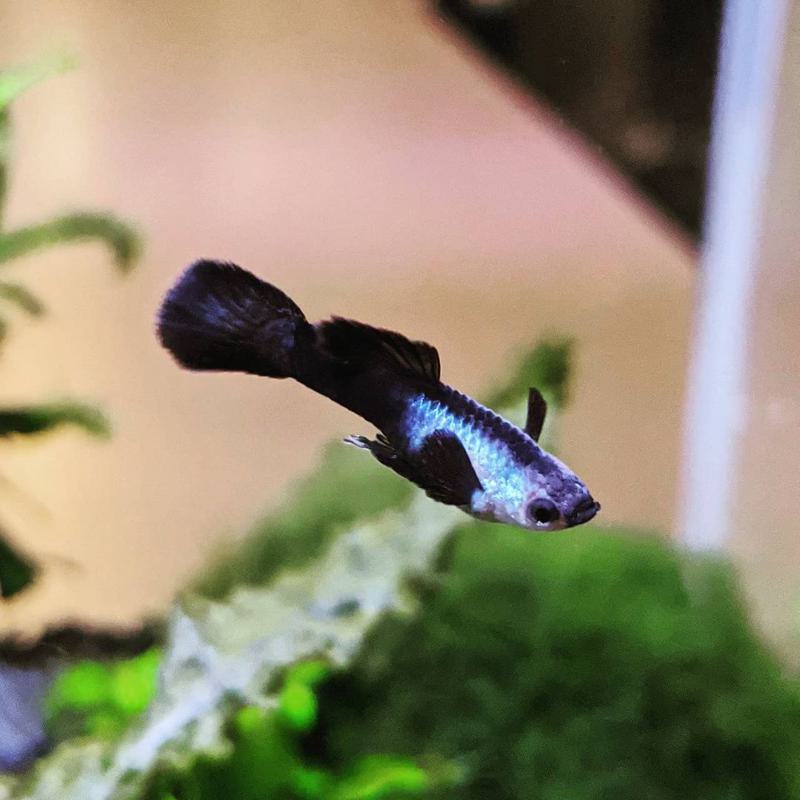
If you have seen a female Panda Guppy, you will wonder how they got their name since their transparent pink color has no relation to land Pandas.
Sexual dimorphism is the reason and the black and white color pattern in males is the basis for their name. Unlike the elongated, elaborate and colorful caudal fin in most male guppies, this fish only has a simple black and round-shaped tail.
Koi Guppy
Bright and multi-colored are the perfect descriptions of this fish, and it is why they are named after Koi Carps.
While they are considered rare, Koi Guppies are widely bred in captivity and aquarists have been able to produce unique color patterns like the Golden Koi Guppy and the Albino Koi Guppy.
Tuxedo Guppy
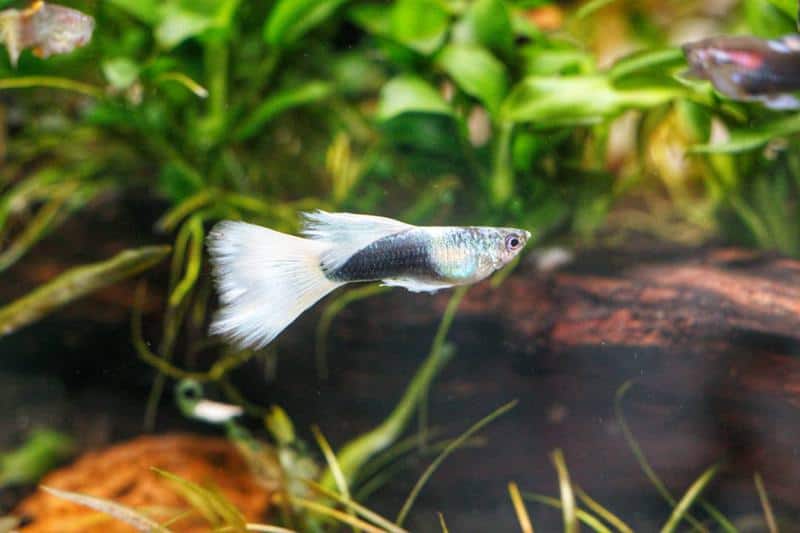
The Tuxedo Guppy has a close resemblance to the Black-Pastel Guppy. Their black and white color combination that looks like a formally tailored tuxedo can easily misidentify them as a half-colored variety.
But make no mistake since this German-bred guppy is more elegant looking than their two-toned cousins.
Cobra Guppy
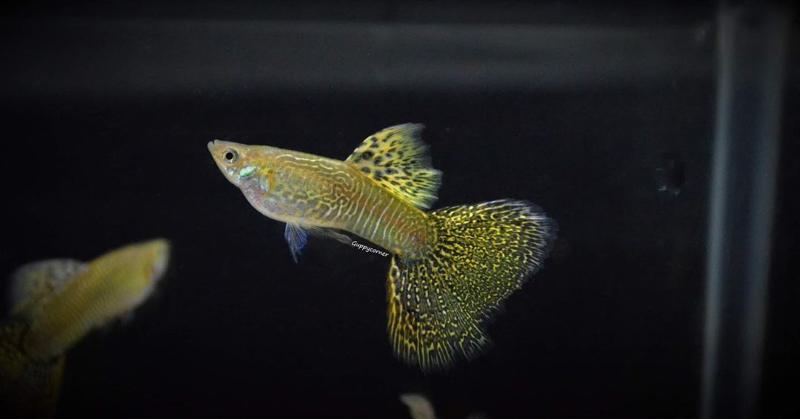
This fish is not venomous and no such thing exists in the entire Guppy family.
Instead, their name was derived from their reticulating black vertical bars that are closely similar to the color patterns found in a cobra’s head.
Snakeskin Guppy
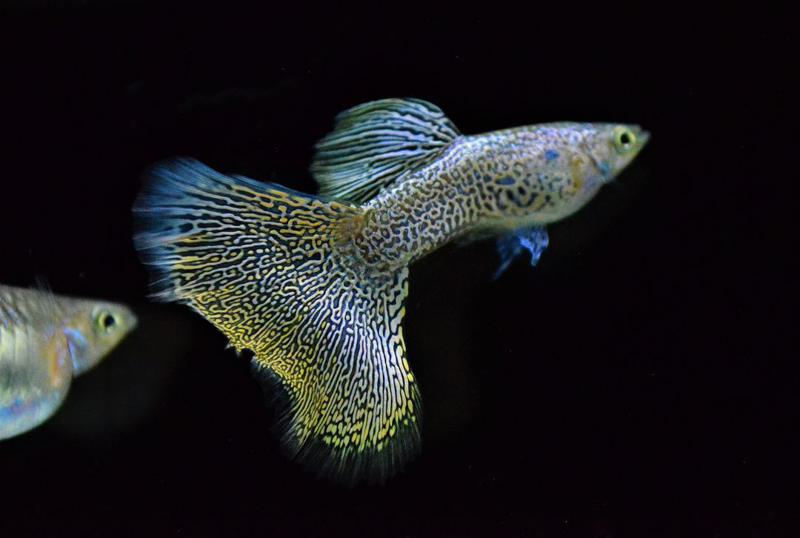
Similar to the analogy we used in Cobra Guppies, this fish does not molt and shed their skin. Instead, they have black vertical patterns similar to those of snakes. T
he major difference that sets them apart from the Cobra Guppy is that their markings is spread throughout their body, and not just in their caudal fins like in the case of Cobra Guppies.
Dragon Head Guppy
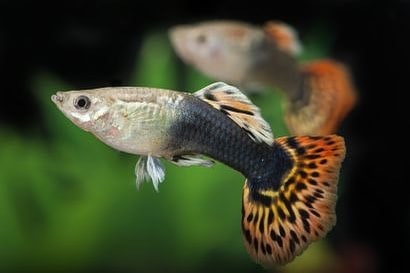
If colors and their combination are the identifying marks of most Guppies, then the Dragon Head Guppy is unique since it requires anatomical examination.
While it may sound intimidating, it is relatively simple. All you need to do is focus on its head and see how elongated and pointed it is, just like a dragon’s head.
Other Types of Guppies Based on Anatomical Variation
Intense body color and elaborate caudal fins are not just the outcome of crossbreeding in Guppies.
In some cases, the genetic mixture from different breeds has caused some variations in their anatomy, adding more sophistication to this already elaborately decorated fish.
Real Red Eye Guppy
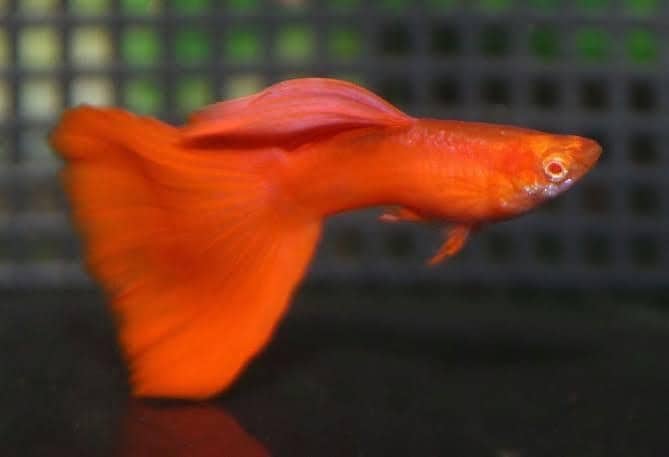
Even if hybrid Guppies are multicolored, it is only shown in their bodies and fins and the eyes are not affected as it inherits the original eye color of their purebreds (which is black). Example is the Red Guppy where its body is entirely colored red, but the eyes are still black.
It is not the case for the Real Red Eye Guppy. As their name suggests, the eyes of this fish are colored red. In the solid red body variety, spotting their eyes may be difficult as it blends and camouflages with its already red-colored body.
Dumbo Ear Guppy
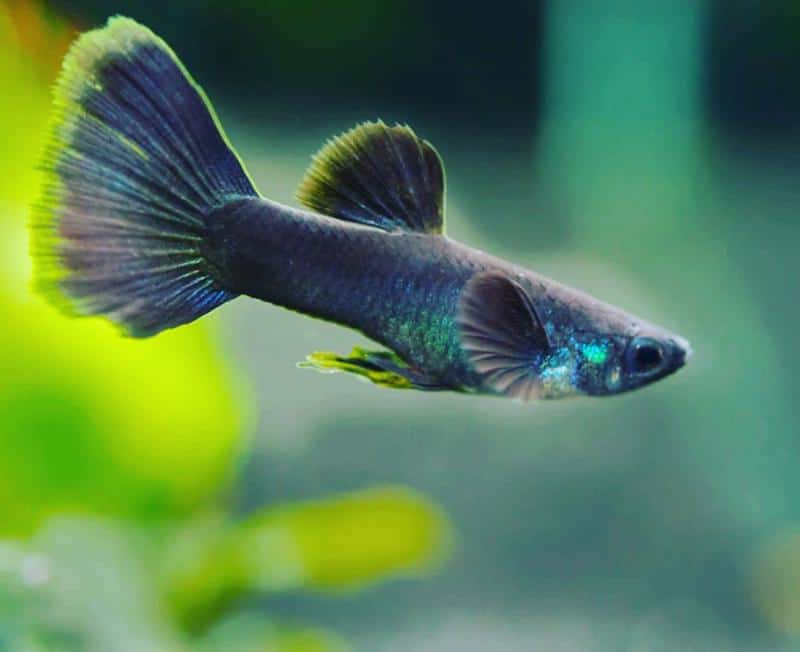
This fish has no ears. Instead, what is highly developed in them is their pectoral fins. This pair of swimming flippers is excessively protruding on their side which looks like an elephant ear.
Also Read:
FAQs
Can I Mix Different Types of Guppies in A Tank?
Yes. Since they are all peaceful, you can mix two or more types of Guppies in a single tank.
However, you need to provide them with enough space and ideal water conditions for them to live up to its reputation.
What Is the Most Expensive Type of Guppy and How Much?
There is no specific type of Guppy that can be considered the most expensive. However, we can categorize them according to their value in the aquarium industry.
Some examples are the Show-Grade Guppies (averaging $20), Designer Strain Guppies ($30) and the Limited-Edition varieties where it can command a price of up to $50 per fish.
Are All Guppies Hardy and Easy to Take Care Of?
Yes. They are considered low maintenance fish, and it is why they are great for beginners and breeders.
Are Guppies and Endler’s Livebearers the Same Thing?
Although it’s easy to mistake Endler’s Livebearers for fancy guppies, they’re different species entirely. They also have important physical and behavioral differences that set them apart.
Final Thoughts
What we have featured is just a fraction of the total variety of Guppies traded worldwide. And we think there is no point in featuring all of the varieties since crossbreeding is continuous and a new variety always comes out.
So, choose your bet, select what type and start keeping Guppies. Who knows, you might be encouraged to breed them and come up with your strain variety.
